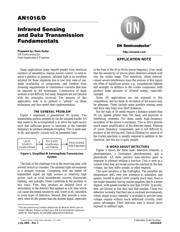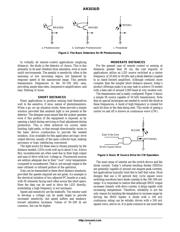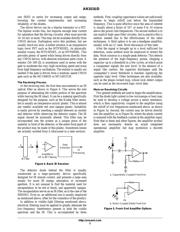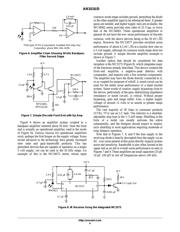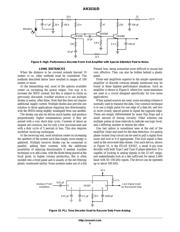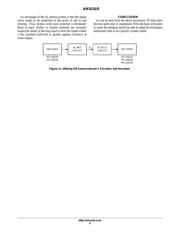Datasheet 搜索 > ON Semiconductor(安森美) > MC34072 数据手册 > MC34072 其他数据使用手册 1/8 页

¥ 1.472
MC34072 其他数据使用手册 - ON Semiconductor(安森美)
制造商:
ON Semiconductor(安森美)
封装:
PDIP-8
描述:
单电源3.0 V至44 V运算放大器 Single Supply 3.0 V to 44 V Operational Amplifiers
Pictures:
3D模型
符号图
焊盘图
引脚图
产品图
页面导航:
型号编码规则在P8
应用领域在P1
导航目录
MC34072数据手册
Page:
of 8 Go
若手册格式错乱,请下载阅览PDF原文件

Semiconductor Components Industries, LLC, 2002
July, 2002 – Rev. 1
1 Publication Order Number:
AN1016/D
AN1016/D
Infrared Sensing
and Data Transmission
Fundamentals
Prepared by: Dave Hyder
ON Semiconductor
Field Applications Engineer
Many applications today benefit greatly from electrical
isolation of assemblies, require remote control, or need to
sense a position or presence. Infrared light is an excellent
solution for these situations due to low cost, ease of use,
ready availability of components, and freedom from
licensing requirements or interference concerns that may
be required by RF techniques. Construction of these
systems is not difficult, but many designers are not familiar
with the principles involved. The purpose of this
application note is to present a “primer” on those
techniques and thus speed their implementation.
THE GENERAL PROBLEM
Figure 1 represents a generalized IR system. The
transmitting portion presents by far the simplest hurdle. All
that needs to be accomplished is to drive the light source
such that sufficient power is launched at the intended
frequency to produce adequate reception. This is quite easy
to do, and specific circuits will be presented later.
LIGHT
SOURCE
Usually Infrared
PROCESSING
Data Separation
RECEIVER
Amplification
and Filtering
λ
Figure 1. Simplified IR Sensing/Data Transmission
System
The bulk of the challenge lies in the receiving area, with
several factors to consider. The ambient light environment
is a primary concern. Competing with the feeble IR
transmitted signal are light sources or relatively high
power, such as local incandescent sources, fluorescent
lighting, and sunlight. These contribute to the problem in
two ways. First, they produce an ambient level of
stimulation to the detector that appears as a dc bias which
can cause decreased sensitivity and, worst of all, saturation
in some types of detectors. Second, they provide a noise
level often 60 dB greater than the desired signal, especially
in the form of the 50 or 60 Hz power frequency. Also, recall
that the sensitivity of silicon photo detectors extends well
into the visible range. This sensitivity, albeit reduced,
causes severe interference since the sources in this region
are often of significant power, e.g., incandescent lighting
and sunlight. In addition to the visible component, both
produce large amounts of infrared energy, especially
sunlight.
Some IR applications are not exposed to this
competition, and for them dc excitation of the source may
be adequate. These include some position sensing areas
and slow data links over short distances.
But the bulk of IR needs require a distance greater than
30 cm, speeds greater than 300 baud, and exposure to
interfering elements. For these needs high–frequency
excitation of the source is necessary. This ac drive permits
much easier amplification of the detected signal, filtering
of lower frequency components, and is not difficult to
produce at the driving end. Optical filtering for removal of
the visible spectrum is usually required in addition to the
electrical, but this too is quite simple.
A WORD ABOUT DETECTORS
Figure 2 shows the three basic detection schemes: a
phototransistor, a Darlington phototransistor, and a
photodiode. All three produce hole–electron pairs in
response to photons striking a junction. This is seen as a
current when they are swept across the junction by the bias
voltage, but they differ greatly in other respects.
The most sensitive is the Darlington. The penalties are
temperature drift, very–low tolerance to saturation, and
speeds, limited to about 5 kHz (usually much less). Next is
the single transistor, having similar penalties (but to a lesser
degree), with speeds limited to less than 10 kHz. Typically,
they are limited to less than half that number. These two
detectors normally find their use in enclosed environments,
where ample source intensity is available to provide large
voltage outputs without much additional circuitry (their
prime advantage). Their detection area is almost never
exposed to ambient light.
APPLICATION NOTE
http://onsemi.com
This document may contain references to devices which are no
longer offered. Please contact your ON Semiconductor represen-
tative for information on possible replacement devices.
器件 Datasheet 文档搜索
AiEMA 数据库涵盖高达 72,405,303 个元件的数据手册,每天更新 5,000 多个 PDF 文件

